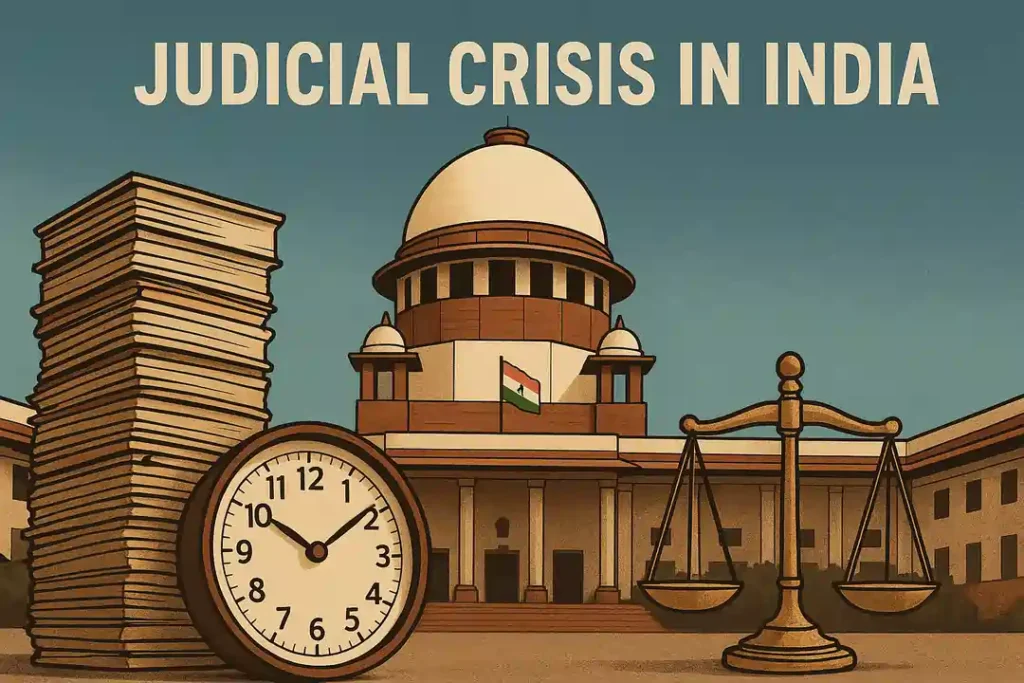New Delhi: In a stark reminder of the mounting pressures on India’s justice delivery system, the Supreme Court of India has recorded its highest-ever backlog of 88,417 pending cases as of mid-September 2025. This milestone, tracked meticulously by the National Judicial Data Grid (NJDG), underscores a relentless upward trajectory that threatens the very fabric of equitable justice in the world’s largest democracy. Far from an isolated apex court issue, this deluge ripples through the entire judiciary: subordinate courts grapple with over 4.7 crore unresolved matters, while high courts shoulder more than 63 lakh cases. As the nation hurtles toward its constitutional centennial in 2050, these figures paint a grim portrait of a system buckling under its own weight, demanding urgent introspection and reform.
The revelation comes at a pivotal moment, just days after the court’s partial reopening from its summer schedule. With all 34 sanctioned judicial positions filled—a rarity in recent years—the Supreme Court disposed of 5,667 cases in August alone, representing 80.04% of the 7,080 new filings that month. Yet, this Herculean effort fell short, as fresh influxes outpaced resolutions, pushing the total pendency to new heights. Civil matters dominate the docket at 69,553, followed by 18,864 criminal cases, highlighting the diverse stakes from property disputes to life-altering prosecutions.
This isn’t a sudden spike; it’s the culmination of years of systemic strain exacerbated by the COVID-19 pandemic and accelerating since 2023. In 2024, the backlog had already crested over 82,000 cases, a figure that seemed daunting then but pales against today’s reality. For 2025 so far, the court has seen 52,630 cases instituted against 46,309 disposals— an impressive 88% clearance rate that nonetheless leaves a widening gap. As Justice Surya Kant prepares for his impending swearing-in as the next Chief Justice of India in late November, succeeding the tenures of Justices D.Y. Chandrachud, Sanjiv Khanna, and the current incumbent B.R. Gavai, the question looms large: Can targeted interventions finally stem this tide?

A Timeline of Escalating Judicial Strain
To grasp the severity, one must rewind to the pre-pandemic era. The Supreme Court’s caseload has ballooned steadily, but the post-2020 era marked an inflection point. Lockdowns disrupted hearings, digitization lagged, and a surge in litigation—from pandemic-related economic disputes to social unrest—flooded the courts. By late 2023, the pendency had become a “perennial phenomenon,” as judicial insiders describe it, defying even the most proactive leadership.
Chief Justice B.R. Gavai, assuming office earlier this year, inherited a court already at full throttle. In a bold move to combat the logjam, he rebranded the traditional May-to-July summer recess as “partial working days,” commencing May 23. During this period, the Chief Justice himself, alongside five senior-most colleagues, anchored the inaugural batch of benches. A total of 21 benches operated in staggered rotations, meticulously hearing and resolving cases until the full court reconvened in July. This initiative, lauded for its innovation, yielded tangible disposals but couldn’t outrun the relentless filings.
Gavai’s predecessors set a precedent for vacancy minimization. Justice Chandrachud, during his stewardship, moved with alacrity to nominate and secure appointments, ensuring near-zero gaps. His successor, Justice Khanna, and now Gavai, have leveraged the Collegium system—the apex court’s internal recommendation body—to propose elevations swiftly. A landmark Collegium resolution from November 2023 laid bare the crisis: “The workload of judges has increased considerably. Bearing in mind the above, it has become necessary to ensure that the court has full working judge-strength leaving no vacancy at any point of time.” The resolution emphasized that even a single vacancy was untenable amid “ever mounting pendency of cases” and a “huge workload.”
The government’s responsiveness has been a silver lining. Recent months have seen executive approvals of Collegium picks within 48 hours, a far cry from historical delays. Yet, as the backlog inches toward 90,000, these efficiencies feel like bandages on a hemorrhaging wound. In parallel, the Centre is gearing up for a high-level meeting to explore the creation of additional special courts, a potential game-changer for high-volume categories like economic offenses and family matters.
Unpacking the Root Causes: Why Cases Languish Indefinitely
The Supreme Court’s plight is symptomatic of deeper rot afflicting the judiciary at large. At the heart lies a chronic shortage of judicial personnel. The Ministry of Law and Justice reports over 5,600 vacancies across the system—a void that hampers efficiency from district levels upward. In high courts specifically, the vacancy rate has deteriorated dramatically, climbing from 16% in 2006 to a staggering 30% by 2024. This isn’t mere arithmetic; it’s a human resource crisis where qualified judges remain sidelined, leaving benches understaffed and calendars overcrowded.
Compounding this is India’s abysmal judge-to-population ratio: a mere 21 judges per million people, in stark contrast to the United States’ robust 150. This disparity isn’t just statistical—it’s a barrier to access, particularly in populous states like Uttar Pradesh and Bihar, where rural litigants wait years for a hearing. The World Bank’s Ease of Doing Business index has repeatedly dinged India for weak contract enforcement, attributing it partly to these delays, which deter investors and stifle economic momentum.
Government overreach in litigation emerges as another culprit. Astonishingly, state and central agencies account for nearly 50% of all cases, often pursuing frivolous appeals or defending outdated policies. From tax disputes to land acquisitions, the executive’s litigious bent clogs dockets, turning courts into arenas for bureaucratic battles rather than citizen redress.
Infrastructure deficits further exacerbate the mess. The India Justice Report 2022 spotlighted acute shortages: insufficient courtrooms, a dearth of administrative staff, and outdated tech that slows transcription and record-keeping. In many districts, judges juggle multiple roles—adjudicating, administrating, even managing security—leaving little bandwidth for substantive justice.
Then there are procedural pitfalls: the absence of statutory timelines for case disposal invites endless adjournments. Litigants exploit lax rules, lawyers cite scheduling conflicts, and judicial vacations—while necessary for recharge—create seasonal bottlenecks. Frequent strikes, strikes by bar associations, and even natural disruptions like monsoons compound these issues, turning months-long waits into multi-year odysseys.
The Ripple Effects: A Nation Paying the Price for Delayed Justice
The mantra “justice delayed is justice denied” resonates profoundly here. Prolonged pendency doesn’t just idle files; it inflicts tangible harm. Victims of crimes endure extended trauma, witnesses fade from memory, and perpetrators roam free, eroding public faith in deterrence. A rape survivor in Delhi might wait five years for closure, while a corporate fraudster exploits appeals to evade accountability—outcomes that undermine the rule of law’s psychological bulwark.
Economically, the toll is staggering. Businesses hemorrhage resources on prolonged contract disputes, inflating operational costs and scaring off foreign direct investment. India’s perennial low ranking in global ease-of-doing-business metrics stems directly from this enforcement vacuum, where a simple commercial suit can drag on for a decade. Individuals, too, suffer: farmers locked in land disputes miss sowing seasons, families in inheritance battles fracture irreparably.
Perhaps most alarming is the human cost in prisons. The India Justice Report 2025 reveals that over half of India’s correctional facilities are overcrowded, with 76% of inmates languishing as undertrials—presumed innocent yet stripped of liberty. Facilities designed for 4 lakh now house over 5.5 lakh, breeding disease, violence, and recidivism. In states like Maharashtra and Tamil Nadu, occupancy rates exceed 150%, turning jails into tinderboxes of despair.
These implications extend beyond borders, tarnishing India’s image as a stable democracy. International observers, from the UN Human Rights Council to Amnesty International, have flagged judicial delays as a rights violation, urging reforms to align with Sustainable Development Goal 16 on just institutions.
Charting a Path Forward: Bold Reforms on the Horizon
Amid the gloom, glimmers of hope emerge from expert recommendations and ongoing initiatives. The Law Commission’s 120th Report, a blueprint from the early 2000s still resonant today, advocates elevating the judge-to-population ratio to 50 per million. Achieving this would require a 138% increase in judicial posts—ambitious but feasible with political will, potentially halving pendency within a decade through phased recruitment drives.
A cornerstone proposal is the All India Judicial Service (AIJS), envisioned as a centralized, UPSC-like mechanism for recruiting district and subordinate court judges. By standardizing selection—merit-based exams, interviews, and training—this would bypass state-level bottlenecks, ensuring courts operate at full complement. Proponents argue it could fill 70% of vacancies within two years, injecting fresh talent and reducing regional disparities.
Technology offers another frontier. The e-Courts Mission Mode Project, now in Phase III, is expanding nationwide with AI-driven tools for case triage, predictive analytics for scheduling, and virtual hearings to minimize physical bottlenecks. Pilots in Karnataka and Gujarat have slashed disposal times by 30%, proving the model’s viability. Integrating blockchain for tamper-proof records and chatbots for preliminary queries could further streamline operations, freeing judges for complex adjudication.
Beyond tech, procedural overhauls are essential: mandating timelines via amendments to the Code of Civil Procedure, curbing adjournments to three per case, and rationalizing vacations with compensatory working days. Special fast-track courts for undertrial prisoners—targeting the 76% backlog—could decongest jails, while alternative dispute resolution (ADR) mechanisms like mediation hubs in every district court would divert 20-30% of civil suits.
The Centre’s forthcoming meeting on special courts signals momentum. Targeting sectors like POCSO (child protection) and NDPS (narcotics), these tribunals could handle 10,000+ cases annually, easing the Supreme Court’s appellate load. Coupled with increased funding—doubling the judiciary’s budget from 0.09% of GDP—and public awareness campaigns, these steps could pivot the system from crisis to cadence.
A Call to Collective Action: Reimagining Justice in 2025
As September 2025 unfolds, the Supreme Court’s 88,417-case behemoth stands as both indictment and imperative. Chief Justice Gavai’s recess innovations, the Collegium’s vigilance, and governmental alacrity offer proof that progress is possible. Yet, without holistic reforms—from AIJS to AI augmentation—the backlog risks eclipsing 100,000 by 2026, deepening societal fissures.
This crisis transcends legalese; it’s a democratic deficit where the powerful evade scrutiny while the vulnerable wait in vain. Policymakers, bar councils, and civil society must converge: fund the judiciary adequately, litigate judiciously, and innovate relentlessly. Only then can India transform its courts from backlog battlegrounds into beacons of timely justice.
In the words of a recent judicial symposium, “Pending cases aren’t paper piles—they’re deferred dreams.” It’s time to awaken them.
Frequently Asked Questions
1. What is the current number of pending cases in the Supreme Court of India, and how does it compare to other courts?
As of September 2025, the Supreme Court of India faces a record-high backlog of 88,417 cases, comprising 69,553 civil cases and 18,864 criminal matters, according to the National Judicial Data Grid (NJDG). This is part of a broader judicial crisis, with over 4.7 crore cases pending in subordinate courts and more than 63 lakh cases in high courts nationwide. The Supreme Court’s pendency, while smaller in absolute numbers, is critical due to its role as the final arbiter, making its backlog a significant bottleneck for justice delivery.
2. Why is the case backlog in Indian courts, including the Supreme Court, increasing despite efforts to reduce it?
The rising backlog stems from multiple systemic issues:
Procedural Delays: No mandatory timelines for case resolution, frequent adjournments, and judicial vacations exacerbate delays. Despite the Supreme Court operating at its full strength of 34 judges and initiatives like working through summer recesses, the influx of 7,080 new cases in August 2025 outpaced the 5,667 disposed, illustrating the challenge.
Judicial Vacancies: Over 5,600 vacancies exist across the judiciary, with high court vacancies rising from 16% in 2006 to 30% by 2024.
Low Judge-to-Population Ratio: India has only 21 judges per million people, compared to 150 in the USA.
Government Litigation: Nearly 50% of cases involve government agencies, clogging dockets with often avoidable disputes.
Infrastructure Shortages: The India Justice Report 2022 highlights inadequate courtrooms and administrative staff, slowing case disposal.
3. What are the consequences of the growing judicial backlog in India?
The backlog has far-reaching impacts:
Social Strain: Families and individuals endure financial and emotional hardship from unresolved disputes, such as land or inheritance cases, impacting social cohesion and India’s global reputation for judicial efficiency.
Delayed Justice: Prolonged cases extend victims’ suffering and weaken deterrence, eroding public trust in the judiciary.
Economic Costs: Businesses face high litigation costs, and weak contract enforcement harms India’s Ease of Doing Business ranking.
Prison Overcrowding: The India Justice Report 2025 notes that over half of Indian jails are overcrowded, with 76% of inmates being undertrials, exacerbating human rights concerns.
4. What measures are being proposed or implemented to address the judicial backlog?
Several strategies are under consideration or in progress:
Procedural Changes: Suggestions include capping adjournments, setting case disposal timelines, and optimizing judicial vacations to maximize court uptime.
Increasing Judicial Strength: The Law Commission’s 120th Report recommends raising the judge-to-population ratio to 50 per million, requiring a significant recruitment drive.
All India Judicial Service (AIJS): A proposed centralized recruitment system for district and subordinate court judges to fill vacancies efficiently.
Digital Reforms: Phase III of the e-Courts Mission Mode Project leverages AI for case management and virtual hearings, with successful pilots in states like Karnataka.
Special Courts: The government is planning to establish more specialized tribunals for high-volume case categories like POCSO and NDPS.
5. How has the Supreme Court leadership responded to the backlog crisis in 2025?
Chief Justice B.R. Gavai has prioritized reducing pendency by rebranding the May-to-July 2025 summer recess as “partial working days,” with 21 benches, led by himself and senior judges, hearing cases. His predecessors, Justices D.Y. Chandrachud and Sanjiv Khanna, maintained near-zero vacancies through swift Collegium recommendations, a practice Gavai continues. The Collegium’s November 2023 resolution emphasized maintaining full judicial strength to manage the “huge workload.” Despite disposing of 46,309 cases against 52,630 filed in 2025 (88% clearance), the backlog persists, prompting calls for broader systemic reforms as Justice Surya Kant prepares to take over as Chief Justice in November 2025.

